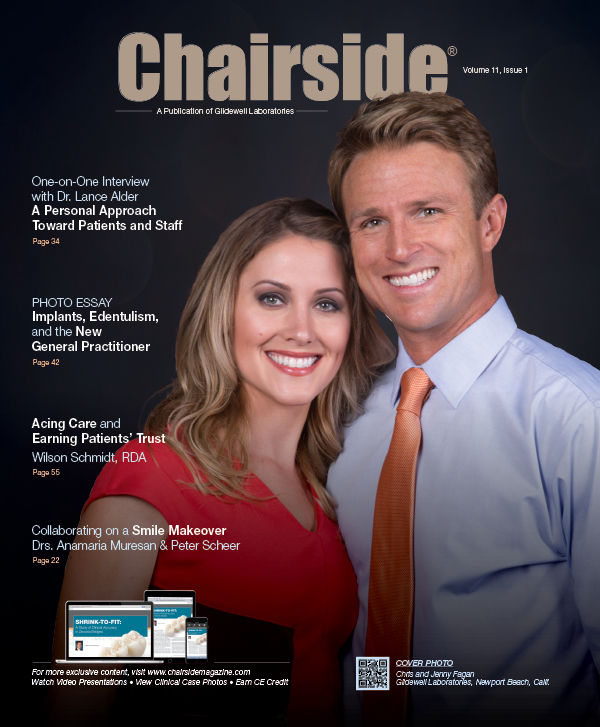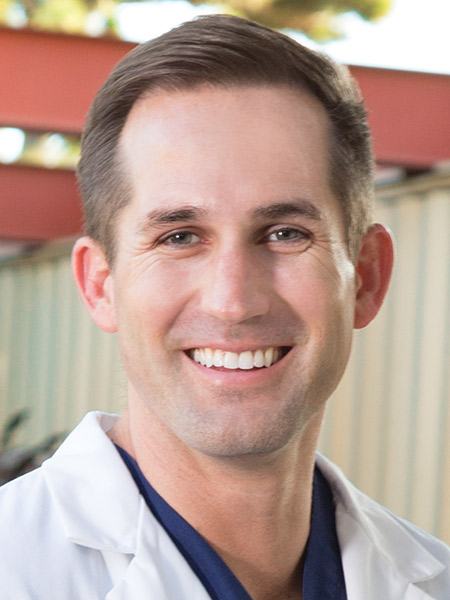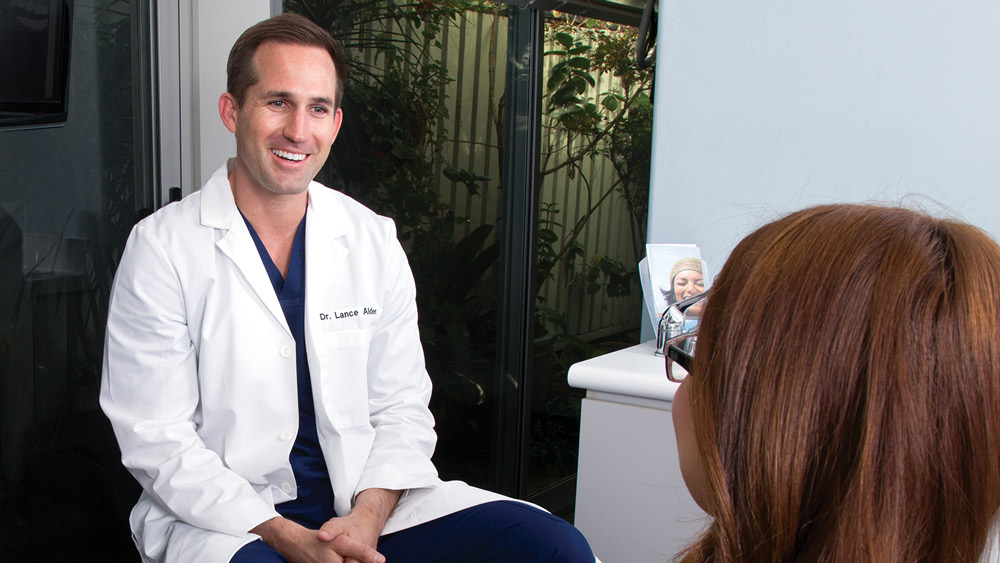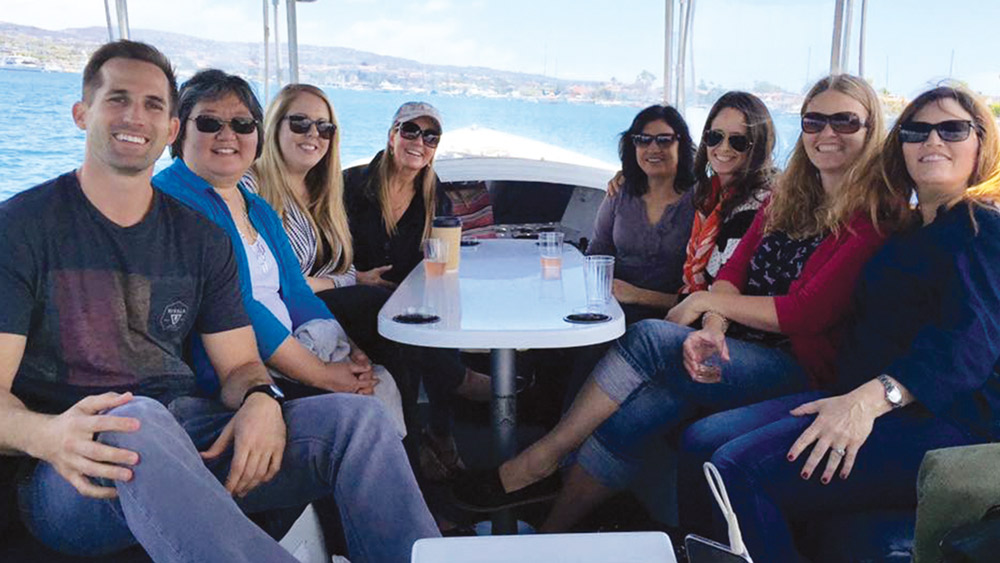One-on-One Interview with Lance Alder, DDS

As a general practitioner who has carved out a niche for himself in the Southern California area, a friend of mine, Dr. Lance Alder, has had to face many of the same challenges we all faced when graduating from the relative safety of the classroom. Things like determining your ideal practice setting, choosing a specialization, building a clientele base, or simply differentiating yourself from the crowd can be an arduous process. Recently, I had a chance to sit down with Dr. Alder to discuss how he came to the decision to leave the corporate world and purchase an existing private practice, as well as how he has continued to grow and thrive in that practice.
DR. SIAMAK ABAI: It is my pleasure to have Dr. Lance Alder here for a one-on-one interview for Chairside® magazine. We’ve known each other for about three years now. We’ve had a good working relationship, we’ve bounced ideas off each other in the past, and it’s nice to have a local dentist in the magazine. Can you take us through your education? Why did you decide on dentistry, and why did you choose Loma Linda University School of Dentistry?
DR. LANCE ALDER: I’ve always been a hands-on person, so dentistry was a perfect fit. Actually, I was deciding between medicine and dentistry at a young age, but I was drawn to dentistry because it’s such an immediate fix. You can have the result right then and there, and you fixed it with your own hands. It’s very artistic. I guess that always appealed to me.
As far as choosing Loma Linda, I think what initially drew me there was their strong clinical program. Also their mission trips. I really liked that they gave students the opportunity to go on mission trips, give back, and get a completely different experience. I took advantage of that when I was there, and did a lot of international trips, but its clinical prowess was the main reason I ended up there.
SA: You mentioned deciding on dentistry at a young age. Was there a particular moment when you were going through undergrad that sparked your interest? That moment when you were like: “Oh! I want to be a dentist.” What was the deciding factor?
LA: I actually decided my junior year in high school, and I never really strayed from that decision.
SA: Really? Wow! That’s great!
LA: In high school, a friend of mine and I were talking about what we wanted to do when we grew up, and we had looked at some of our friends’ parents who were in the medical field and the dental field, and we kind of liked the dental. It wasn’t because dentists made the most money (which we all know isn’t true), but because they seemed to have a lifestyle where they had time to do as they pleased, time for their families — especially the people who had a solo practitioner office. It just seemed appealing. Obviously, we were only teenagers at the time, but that’s when I decided. And then as I got older, I began to love it for different reasons.
SA: I’ll tell you about when dentistry became my path. I was a third-year undergrad doing research in the neurology department. Because I had been there for three years, I was pretty far advanced in that field, and we were doing surgery on rat brains. It was literal microsurgery. And I was sitting there, really focusing, my hands shaking a little bit with the nerves, and I thought: “You know, this is very delicate work. How can I transfer this to working on somebody?” It was clearly medical school or something to that effect. So I transferred to dentistry. I’m still able to do that delicate work and be productive and make money, but still have a little bit of time to enjoy life.
LA: Right. It’s rewarding work.
SA: So you were involved with corporate dentistry for a little bit, but also private practice at the same time. Can you talk about that phase in your life, and what you liked and didn’t like about either one? What are some of the advantages and disadvantages?
LA: Sure. So right when I graduated, I started working with Pacific Dental Services (PDS) (Irvine, Calif.), and I was also interviewing in private practices. As any new graduate does, I was just looking for anything that was going to stick.
SA: Right. Get a job and start paying off those student loans.
LA: Exactly. I got a job with PDS, but I started working there and found it wasn’t a fit for me. It was a nice, high-tech office, and PDS has great training. That was one thing I can definitely commend PDS for: They teach you a lot about time management and using the CEREC® system (Sirona Dental Systems, Inc.; Charlotte, N.C.), and I definitely learned a lot of new things there.
SA: I was part of Pacific Dental when I first got out of dental school, too. I worked for them for about a year and a half. They do invest a lot in their dentists, which was definitely appreciated. They put a lot of work into developing young talent for their offices.
LA: For sure. But all you had to do was worry about your part, the clinical part, and I quickly realized that not being in control of everything as far as the practice went was not for me. For some people, it’s great. Some people want to walk in, do some clinical, and leave. But I’ve always liked business, and I’ve always liked the business side of it. I’ve always been able to look at numbers and enjoy figuring them out; for example, how to reduce overhead and increase production, which is something you don’t have the ability to do when you’re in a corporate setting. So shortly after that, I left and went to a private-practice setting, which is where I’m currently at. I have my own practice, and that’s been a perfect fit for me. I have the ability to dial it in exactly how I want, where I get to focus on the procedures that I want to focus on.
SA: That was the disadvantage with PDS for me as well: That you’re never going to be in control, like you said. It’s beneficial because you get an opportunity to maybe buy into some of the practices, but you’re going to own 49% of the practice and Pacific Dental will own 51%.
LA: Right.
SA: And I realized that any major decision I wanted to make for the practice would have to be run through corporate. That was not something that I was looking for.
LA: I agree. I feel much better having more control of my practice.
SA: Do you accept HMO, PPO and fee for service in your practice, or is it just PPO or fee for service?
LA: No HMO. Just PPO and fee for service. We’re about 50% PPO and 50% fee for service. We’re just in network with a handful of plans, the plans that work for us.
SA: How do you get the patients into the office? Is it just word of mouth, or do you have routes for advertising?
LA: We’ve been blessed enough to have most of it happen through word of mouth. In the beginning, when I first took over the practice and was revamping the office with technology, we allowed the company that made the website to do some marketing. But I quickly found out that brought us the wrong type of patient. It brought us a lot of patients who were looking for a quick fix, the emergency patient that wasn’t going to be a long-term patient interested in building a relationship.
SA: Or the price-shopping patient, maybe?
LA: Right. So we didn’t do that for too long. I created a Yelp page, and we have a nice website. I think a typical patient is going to Yelp you first, and then they’re going to go to your website and research you, take a look at you and your office, try to get to know you, and only then do they end up in your office. That is one nonpaid website that actually has brought us a lot of patients.
But we really focus on getting new patients in through our current patients. We invest a lot in our patients to encourage word-of-mouth referrals. For instance, we give really great new patient bags; I write a handwritten note to every single new patient to welcome them to the office. We have a free Sonicare raffle every month and post it up in the operatory slideshows to get patients participating. Most of all, we have a great personable staff with a low-pressure, comfortable office. I’ve found this is something our particular patients search for.
SA: The personal touch.
LA: Sure. And also a huge thing for us is our relationship with our local team specialists. We are very close with our neighboring pediatric office and orthodontic office. We work a lot with them and help with referrals back to them. It is a great mutually beneficial relationship.
SA: So basically just making sure that you take care of them, that they feel like they’re special. And they are special, because they’re your patients. You’re put on this planet to take care of them.
LA: Yes.
SA: So your practice is in Orange County, California, an area very saturated with dentists.
LA: Yes, it is.
SA: What makes your practice stand out? Like maybe somebody has told you, “This is why I like your practice.”
LA: I think that really comes down to our office and our staff. When a buyer walks into an environment and immediately has a connection with someone or something, they’re likely to enjoy it that much more. We have a very efficient and friendly staff that makes our patients feel at home. We also have an office that has that same feeling, the feel of a comfortable, homey environment, and I think that’s something that patients really like. It’s kind of a smaller boutique office, where a patient isn’t wondering if their crown’s going to buy our next big piece of equipment, or new marble or granite countertops, or any number of other things. That allows them to trust our staff and to trust me, and that’s really what keeps them coming back and accepting the treatment we recommend.
SA: I can relate to that because I was part of a really fancy office, and the patients would come in and look around and say, “This is why you’re so expensive,” even though our fees were average compared to all the other dentists in the area. So they would come in and literally tell me, “Of course you’re so expensive, because you’re paying for this and that, big screen monitors, and all that stuff.” But I know that when you took over the practice, you did want to make it a modern practice, just not so modern that the patients don’t feel comfortable anymore coming to your practice. What was the first step for you?
LA: Yeah, we kind of changed the motor under the hood, but left the car looking the same, so to speak. The first major change was to go paperless. We got new management system software, which happens to be Dentrix® (Dentrix Dental Systems, Inc.; American Fork, Utah), and went completely paperless. That makes everything that much smoother and more available to myself and my staff when we’re working with patients. That was the first thing: the computer and technology, which from the outside isn’t a large change, but from the inside …
SA: Right.
LA: There were already digital X-rays, but we got a new system to integrate them with.
SA: Which one are you using?
LA: DEXIS® (DEXIS, LLC; Hatfield, Pa.).
SA: DEXIS. OK, so DEXIS and Dentrix?
LA: DEXIS and Dentrix.
SA: Pretty standard, and they’re actually very good systems.
LA: That was the first thing I did. And I got intraoral cameras for every operatory, which has been huge. Very, very helpful. Patients never like to see their teeth, but when they do, they know what they need to fix right off the bat.
SA: The skepticism goes away once they see the picture.
LA: Just put it up and they’ll ask how they can get it fixed. The other addition was our website. We got an online presence, which was nonexistent before. That’s definitely something that has to happen in a modern practice: You have to have some sort of online presence. More and more, patients are searching from their computers and mobile devices to find anything.
SA: And before you didn’t have that?
LA: No. There was no website, no online presence of any sort.
SA: And what’s in the future? I know you transferred to electric handpieces, which was big for me — I mean, I can’t work without electric handpieces now that I’ve used them. What’s the next step for you? Intraoral scanner? Maybe an in-office milling system?
LA: We did get an intraoral scanner. I did do that. I took that step last year. I got the 3M™ True Definition Scanner (3M™ ESPE™; St. Paul, Minn.).
SA: Very nice. I’ve had some experience with the 3M True Definition, and it’s an excellent scanner.
LA: I’ve been working with that a lot, and I really like it. It’s been a great scanner. It’s sped up the flow of our crown preps and impressions, and our lab time is drastically cut. I don’t do the in-office milling at this time, and I don’t know if I plan to. I really like the lab I have, and they’re very quick and affordable — about a three- or four-day turnaround — and they drop right in perfectly. For me, that’s a good fit. But we got the intraoral scanner, and we’ve been using that. It’s great not having to deal with the shipping and the labeling and the two-week turnaround.
SA: Do you have the panoramic machine, or the cone-beam CT scanner?
LA: That would be ideal. I don’t know if I have the space for it, but I would like to have a CBCT.
SA: How about the transition from being a GP practice, where you referred some of the implant and perio cases out, to one where you brought somebody else into the practice?
LA: I looked at the things that I could realistically add into my practice that would maintain the relationships that I have with some of the referring doctors, but still turn it into a partial group practice without having to expand the size or the number of chairs. And what made the most sense was bringing in a periodontist. I felt that endo was something that patients can’t always wait for. When they come in with a toothache, you can’t always say: “Our endodontist will be here next Wednesday. Come back in then.” I ended up referring out endo a lot, and wanted to bring that in-house. I met with a few different periodontists and decided on one that was a good fit for the practice. It was a little bit of a tricky process to get her credentialed with one of the insurance plans we were on, and get her into the practice and her fees put into our system. Luckily, Dentrix is set up to have multiple fee schedules, so the transition was just bringing her on board and getting her to be part of the team and having patients get to know her. Our patients really like it because they don’t have to leave to another office to get those procedures done. Now when they come in needing an implant, they’re in our office from start to finish. They don’t have to go anywhere, which I really like. It’s been a good move.
SA: Yeah, they don’t have to fill out new paperwork, meet new people. Or maybe they’re just comfortable with the dental chair in your office. That’s a big advantage.
How do you keep your staff happy? Do you have little outings just for fun? Do you guys go bowling just to get everybody on the same page?
LA: I try to have lunch once a quarter with everyone on my staff just to sit down with them. Maybe we don’t even talk about dentistry. Maybe we just sit down and talk about their families and their vacations and just enjoy that. And then every year I sit down with them and try to make sure that they’re happy, and that they’re taken care of, and find out if there’s any needs that aren’t being met. I’ve taken steps to have medical insurance paid and retirement plans contributed to for our full-time employees. Things like that.
SA: Yeah, you have to invest back into them. The same thing that PDS was doing. You have to take care of your employees and they’ll take care of you.
LA: Right. I think as long as their needs are met and they feel important, that’s the big thing. Beyond that, we just try to keep the office very fun and lively. We get together in a social environment about every 3 to 4 months as well. We’ll do Duffy boat rides in the harbor, we’ll go meet at the bowling alley and have them bring their spouses to go bowling. We, of course, have a Christmas party, a Christmas dinner with the spouses. And if we ever have a day where a patient or two cancels and we suddenly have a longer lunch, I’ll take them out to lunch next door at the Mexican food restaurant. That’s always nice.
SA: When you transitioned into the practice, did you retain all the staff from before? Or did you have to hire some?
LA: I decided that with ownership changing hands, changing the practice as little as possible was the best way, so the only thing I did was paint the walls. Nothing else inside the office changed. None of the staff changed. I wanted to make the smallest possible ripple in the water. And, looking back, I think that was huge in helping to keep patients.
SA: Yeah, patient retention.
LA: Patient retention. There wasn’t that typical, “I’ve been seeing Dr. Smith for 25 years, and now there’s a new person, and I don’t even want to give him a chance. I’m just going to ask my neighbor who they see and go to a new office.”
SA: That poses a really good question. The patient’s been seeing the previous dentist for 20 years, and the previous dentist felt that he could put off some of the procedures for a long period of time — you know, you have some amalgam restorations that are serviceable but not detrimental. Now the new dentist comes in and has a different mindset of diagnosing and presenting to the patients. He thinks it would be to the patient’s advantage to have those amalgams replaced because they’re forming cracks, and they might fracture the teeth. I’m sure you’ve come across some of these cases. There’s always that issue. How do you relay that information to the patient without them feeling like, “Oh, the new guy wants to make money”?
LA: Education. That’s what it comes down to: the patient understanding the reason for it. We’re back around to the whole photography thing, the intraoral camera. That was huge. I had a folder that I put on each computer desktop that had a handful of pictures of molars with amalgam fractures, a whole bunch of snapshots of all these molars that had been cracked, and then the after photos. I would sit down with patients and show them a picture of their tooth, then go through the folder of some examples of what could happen without treatment and explain to them why a crown was needed and how it would help.
I think the general answer to the question is to educate patients and let them see for themselves examples of what can happen. Patients understand that everyone has a bit of a different personality. If they trust you, they’ll be open to listening to your response.
SA: And like you said before, the pictures are huge. I mean, it helps so much, just involving them in the decision-making process.
What’s your go-to route for continuing education? I mean, you’re busy with your practice. There’s a lot of involvement during hours, after hours, all that stuff; when you’re like, “Hey, I need my units, I’m interested in Invisalign® (Align Technology, Inc.; San Jose, Calif.) or something else,” where do you go for that? Do you go to conventions? Online?
LA: Conventions, I think. I’ve gotten in the habit of going to CDA. Typically speaking, I try to get to CDA Anaheim as well as CDA San Francisco. I get a lot from those. On top of that, I’ve taken courses for things that have drawn my interest that I want to be a part of. For instance, I wanted to have an Invisalign practice, so I took advanced Invisalign classes, and still take them. I thought I wanted to place implants, so I went and took an implant course, but I realized it was better in someone else’s hands than mine with how often I would be doing them. I’m glad I did, though, because I know things that I wouldn’t have known if I hadn’t taken the course.
SA: Right.
LA: I also went to the Dawson Academy and did an occlusion course, but for the most part, I stick to conventions. Outside of them, it’s mainly been the things that interest me clinically, although I did just go to the Dentrix course with my office manager and front office gal to help them with their Dentrix skills.
SA: How has Invisalign helped you grow your practice?
LA: So many people need Invisalign, and now that I’m trained in Invisalign, I can keep cases that I might have once let go. I have an extra tool in my bag to fix issues and not just let them go. On top of that, the orthodontist I work with actually likes it because now I’m looking at a lot more orthodontic cases, and I refer them more cases than I used to. I still refer out a lot of ortho because there are things I just feel an orthodontist should do.
SA: Absolutely.
LA: But the vast majority of adult patients that had orthodontia in their youth have adult relapse, so for them, a six- to 12-month treatment to get their teeth back where they want them to be, or to get their front teeth level again after being crooked for the last 15 years, is a great fix. And it’s greatly grown our practice. Invisalign does such a good job marketing their own product that patients are already aware of what it is and, for the most part, have someone in their life who has done it and knows how it works. It’s been big for our office.
SA: Nice. So what’s in store for the future? What are you interested in? Expanding? Maybe adding to your skill base, knowledge base, doing different procedures?
LA: I would like to grow. We’re currently open four days a week, but we’re paying rent for seven days a week. My goal would be to grow the practice to where we’re required to add on a day, or even two, which would require me to add on an associate. And then for myself, to continue my training with Invisalign and cosmetic dentistry.
SA: Cool. Well, best of luck.
LA: Absolutely. Thanks.







